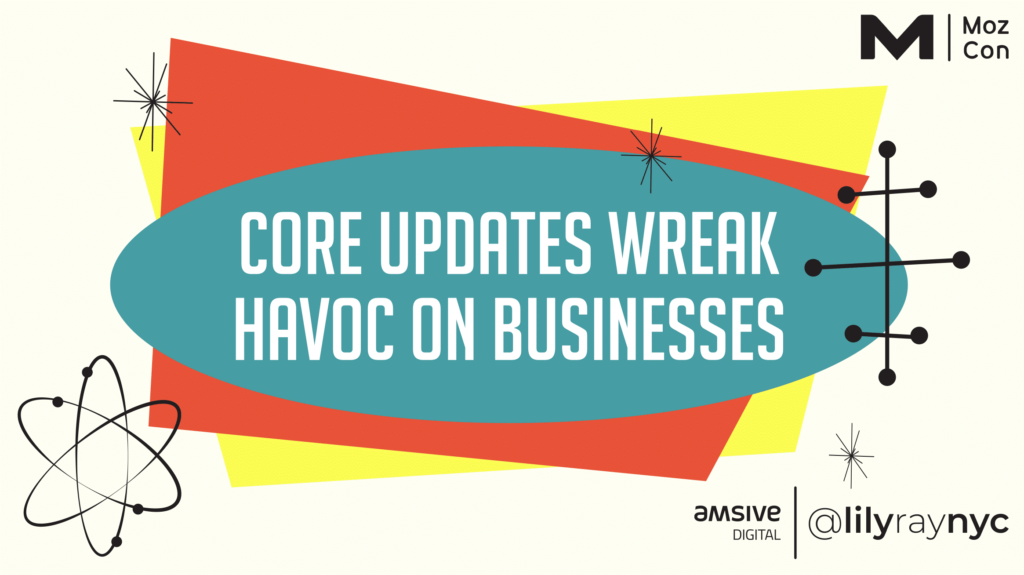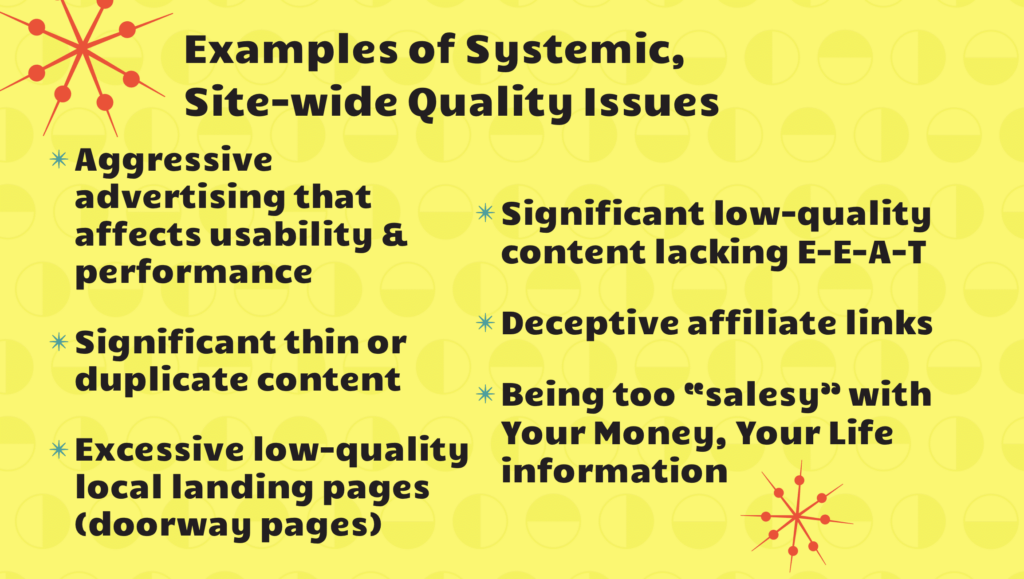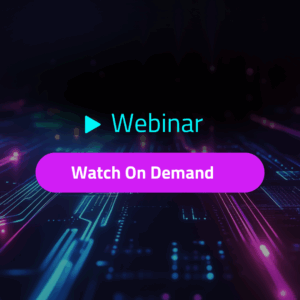Adapted from the MozCon 2023 presentation, Google’s Just Not That Into You: Understanding Core Updates and Search Intent by Lily Ray, Sr. SEO Director and Head of Organic Research at Amsive Digital.
Jump To:
Navigating the ever-changing terrain of Google’s algorithm updates can often feel like a perpetual challenge for marketers. Just as you adapt to one update, another wave of changes comes rolling in, causing you to revisit and revise your site content.
So, how can you stay a step ahead in this relentless game of change? Learn more as we unpack the world of core updates, unveiling strategies that enable you to adapt, evolve, and excel in this dynamic digital marketing landscape.
A Brief Rundown on Core Updates
Google releases core updates every few months with the objective of refining its search results. During these updates, ranking signals can be augmented, removed, or tweaked. This accounts for the fluctuations website owners frequently observe in search rankings concurrent with the timeline of core updates.
Core updates are not meant to target specific sites or pages. Google asserts that these updates aim to “improve overall how our systems assess quality.” Despite this, it’s common for many sites to experience a significant decrease in rankings post core updates, indicative of problems Google has pinpointed within those sites.

Identifying Common Site Quality Issues
Several site-wide issues that tend to be flagged during core updates include:
- Invasive advertising that impairs site experience
- Superficial or repetitive content
- Copious low-grade local landing pages
- Content lacking in E-E-A-T (Experience, Expertise, Authoritativeness, Trustworthiness)
- Misleading affiliate links
- “Money pages” that are excessively sales-oriented
There have been instances of websites that experienced significant ranking drops after creating an abundance of duplicative, low-value local landing pages. Such tactics might yield short-term results, but core updates typically expose and penalize these strategies in the long run.
The presentation includes some examples, including a site that saw big drops after building large numbers of duplicative, low-value local landing pages. This strategy may work in the short term, but core updates often catch up to these tactics, causing traffic to take a nosedive until site content is improved. Next, we’ll cover a few ways that you can prevent this from happening to your site.
Mitigating the Impact of Core Updates
While core updates are an inevitable part of Google’s algorithm evolution, certain strategies can help mitigate their impact:
Regularly Update Content: Ensure your content is current and valuable, catering to Google’s preference for fresh and relevant information.
Focus on User Experience: Prioritize the improvement of page load speed, mobile-friendliness, and overall site usability – factors Google is increasingly considering in its ranking algorithms.
Prioritize E-E-A-T Principles: Create and review content adhering to Google’s E-E-A-T guidelines by citing authoritative sources and operating transparently.
While marketers can soften some of the impact, being able to identify larger search patterns over time is key in staying ahead. Now, let’s take a deeper dive into understanding these shifts in search intent.

Decoding Shifts in Search Intent
A primary catalyst for ranking volatility during core updates is the continuous refinement of Google’s algorithms in understanding user intent or the user’s goal when typing a query. It’s not uncommon for the ranking of the same keyword to shift drastically between different core algorithm updates.
For example, rankings for “Barbie” changed from general info to reviews of the new Barbie movie. Even very generic words like “conference room” and “jukebox” changed to favor new meanings of those phrases after core updates.
It’s crucial to have access to the knowledge to identify these major shifts by working with an SEO expert. You need to see exactly what types of new sites are ranking for your keywords and determine how to match those new intents better.
Creating Content for All Possible Intents
A key strategy for handling intense shifts in search intent is to build content that serves every possible intent for your important keywords. This may require different site sections, articles, videos, images etc., that each serve a unique purpose for searchers.
Search intent, an integral aspect of SEO, can be classified into four main categories:
- Informational Intent: Users seeking information. Provide comprehensive and valuable content to answer their queries.
- Navigational Intent: Users trying to reach a specific website. Make your brand or product names clear and findable on search engines.
- Transactional Intent: Users ready to purchase or use a service. Optimize your product and service pages for these search terms.
- Commercial Investigation Intent: Users compare products or services before purchasing. Provide clear, detailed information and consider creating comparison content if relevant.
The goal is to cover all the bases – informational, navigational, transactional, and emerging intents like voice search and featured snippets. If you provide results search engines believe best serve user intent, your pages will be well positioned regardless of core update volatility.
In the ever-evolving world of Google’s algorithmic updates and the fluid nature of search intent, gaining a grasp on these complex dynamics is crucial. Here’s what you can do next:
- Stay Informed: Keep abreast with Google’s core updates. They may cause volatility in rankings, but they also provide opportunities to learn about the factors that Google values in quality content.
- Analyze Search Patterns: Work with an SEO expert to delve into your site’s search data and observe the changes in search intent for your keywords across different updates. This will offer you insights into how to match your content more effectively to these shifts.
- Build Diverse Content: Cater to all possible user intents. By ensuring your content covers informational, navigational, transactional, and even emerging intent types, you align yourself with Google’s mission of providing useful and relevant results.
The insights provided here are your starting point, but this is just the tip of the iceberg. To understand the interplay between core updates and search intent, view the original slides from the MozCon 2023 presentation below.
SLIDES: Google’s Just Not That Into You: Intent Switches During Core Updates
Unravel the Mysteries of Google’s Core Updates
Understanding the dynamic nature of Google’s core updates and their effect on search intent is a crucial part of a data-driven, performance-based strategy, equipping you with the power to optimize your SEO efforts effectively. Dive deeper into the strategies for creating diverse content to cater to every possible search intent, or let’s talk about how to leverage these insights for your marketing efforts — and elevate your business.







